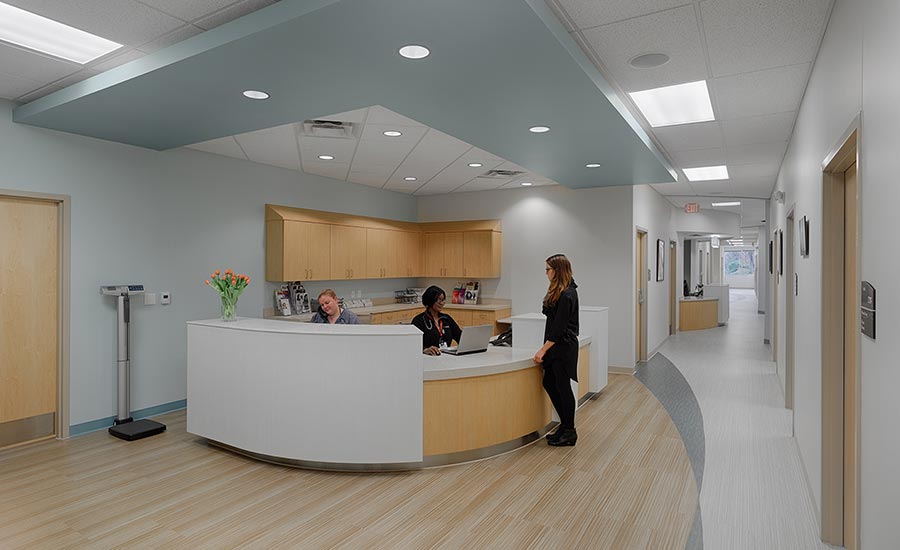The Opportunity
In the first quarter of 2020, the Starnet cooperative believed out to 2023 that the segments with the greatest opportunity for our membership were education and healthcare. Particularly exciting were the subsegments of K-12 education and ambulatory care. They stood out as rich areas for members to connect the dots between end users, architectural and design community, developers, general contractors, and their favored manufacturers.
The balance of 2020 was highly disrupted due to the pandemic and punitive political behavior, which put much of the independent entrepreneurial spirit of North America on pause. Starnet began to search for success paths, anticipating these long-term segment opportunities will return in 2021. Looking to the success of trends that can be adapted from other industries often provides clear plans for Starnet members to rally around and Partner for Success!
In Search Of Certainty
One example from the healthcare industry that has been successful is the group purchasing organization (GPO) industry. GPOs help healthcare providers improve patient health, reduce costs, and increase innovation throughout the healthcare system. In the healthcare industry, the decision to join a GPO is made at the executive level. The GPO model impacts the entire decision-making process and supply chain management of the member organization. The GPO model is an evolution in procurement that will have long term impact on the interior finish products and services market. Group purchasing organizations have evolved over time and have given way to modern iterations, including online group buying or “social” purchasing. The model has now been consumer mainstreamed, supported by easy technology, and is unavoidable. Some major GPO companies serving the healthcare industry are HealthTrust, Vizient, and Premier, Inc.
Many GPOs offer a broad range of services beyond cost-savings to achieve superior patient outcomes. GPOs are also supporting healthcare members on facility planning and management, interior design, construction, and other major capital investments. Starnet has a lot in common with GPOs in the way we support our membership across so many areas of the business.
It is estimated by the Health Care Supply Chain Association (HSCA), an association that represents the leading GPOs for healthcare, 98% of the acute care facilities in the United States are utilizing the services of a GPO. In addition, they estimate more than 7,000 acute care and 68,000 non-acute care organizations are using GPO services. By any reasonable view, that is a successful business model showing widespread success in an industry coveted by the commercial flooring contractor. Those 75,000 organizations operate in hundreds of millions of square feet of interior space. It is an astounding opportunity for the industry to marry the GPO model with some of the best clients in the world to improve the efficiency and outcomes for patient care.
Haven’t I Heard About This Before?
While cost-savings remain central to the GPO core mission, hospitals and healthcare providers are increasingly relying on GPOs for a broad range of services. Procurement of daily use items such as medical disposables and medications has broad adoption. GPO see capital expenditures in construction as a key growth area. The massive size of the spend and the direct connection of facilities to healthcare staff’s ability to produce positive medical outcomes provides support for more adoption. As with most innovation, there is systemic resistance to the GPO model for procurement and management in construction. There have been many examples of limited scope success through the years. We have seen intensity around this concept rise and fall in our industry with narrow execution of GSA contracts, dealing with federal, state, and local government, industrial manufacturing, electronics, agricultural, retail, and grocery client managed procurement models. Individual manufacturers or service companies will often celebrate limited successes as outstanding achievements, “I achieved $7 million in sales on the state contract!” This may be an admirable achievement individually, but the real opportunity may be ten times greater than any number ever quoted using the Partnering for Success approach.
Are We Part Of The Solution?
In a healthcare organization, capital budgeting must be a detailed process due to the complexity. Capital expenditures, estimated at nearly 25% of the annual budget, are second only to labor spend in most healthcare organizations. Incremental to the baseline of complexity is the number of individuals required to be involved in the process. Traditionally, no one division of a healthcare organization owns the entire capital budget, which is a perfect opportunity to utilize the GPO model to ease execution. It can provide structure to an internally chaotic and highly political process. In many businesses, the budgeting decision-making process is handled by senior management and owners of the organization. Healthcare has an element that separates itself from almost all other industries, the dominant role of a powerful group of stakeholders—the medical staff. The staff is the method of production supported closely by the facility itself. Our industry has an incredible opportunity to align and execute in support of the GPO procurement model in healthcare. Because of the complexity in supplying the capital investments, the GPO model is often reduced only to pricing. Unfortunately, this devalues what the GPO are selling to their healthcare clients. Because commercial flooring products have no value unless supported by locally informed expertise and outstanding installation services, a Stock Keeping Unit (SKU) price is meaningless in the total scope of a GPO transaction. We must embrace this procurement model as a path to success for all stakeholders, most importantly the manufacturer and the professional flooring contractors that make the SKU’s valuable together.
What Is Holding The Industry Back?
Some of the Starnet members have had reasonable success in local markets working with GPO, but express frustration in satisfying clients once transient managers located far away from the client healthcare account begin to unwind the local value proposition. When decisions are remote, they often fall to price of material only, and the client suffers from the compromises made along the way that disconnect that SKU purchase from the full value delivered by a Starnet professional flooring contractor.
Ken Clifford, president of Diversified Flooring, Inc., in Salt Lake City, Utah, has worked with many healthcare clients over the years. His longest relationship managing the needs of a particular major healthcare client spans 19 years.
“It normally takes us at least a year to educate clients to match up their regional or national needs with our capability The need for facilities to maintain patient care must be aligned with the process of flooring installation. While we are helping the client build a repeatable system to complete their projects, they must continue their old process to finish projects already committed. It is normal for them to become more and more excited about our services because everything we warn them about continues to happen over that year in facilities we are not managing. That builds trust and credibility, but it takes too long. The GPO are primarily interested in demonstrating their value on paper, which is unfortunately concentrated on price. The GPO advertise value, but the real delivery of value happens locally, and it is not a price. Value is connected to better performing healthcare workers taking care of patients on professionally installed commercial flooring that supports care. We need more partnership around the GPO model that connects the product SKU purchase to the real value provided by flooring contractors. Everyone can benefit from the partnership to deliver better outcomes.”
Capability of A Single Stakeholder Is Not Enough
The traditional approach from the manufacturer has been to take the responsibility for GPO transaction in order to control the purchase of one element, carpet or resilient, and then use the mask of ‘turnkey solutions’ to outsource the balance of the project. This masks some of the pricing issues that were not managed holistically during the GPO Request For Proposal process and has driven salespeople and distributors mad with frustration. Often this is also the only way for them to provide the purchase data to the GPO. This hides the inefficiencies behind one brand and creates huge levels of risk.
Ken Clifford shared:
“We have developed reliable processes for reporting to support the obligations of manufacturers. In some instances, we have held the value chain together for several manufacturers over multiple years, but personnel changes have often dismantled successful situations. No manufacturer can provide everything, and the accessories and specialty items often make the project work. Sometimes the GPO healthcare member hospital has a change in staffing or the manufacturer changes their approach. That is extremely disruptive, and the client suffers. I believe that the GPO model could provide more stability to smooth the transition as people in key positions change, but price cannot be the foundation. The foundation has to be value and performance, which cannot be disconnected from professional installation and local operational knowledge of that client facility.”
On the service side, companies that travel coast to coast to manage endlessly unique healthcare installations are rare, and the intensity required to service healthcare clients is best delivered regionally. That means that flooring contractors must put geographic limits on their account responsibility, handing the next project off to a trusted local contractor to follow standards expected by the client as closely as possible. This is where the Starnet cooperative can add outstanding value connected to a GPO for continuity. The Starnet members support each other to make sure the client satisfaction remains high and they return again and again for that experience. Each stakeholder—manufacturer, architect, designer, general contractor, GPO, member organization, flooring services provider—can dazzle the client if they work together inside the procurement model as it has been marketed to the executive team. It must be focused on value and outcomes. That is a big playing field for Partnering For Success, and there is room for everyone.
Call To Action For Partnership
The day the GPO agreement is signed, the manufacturer is unable to meet all of the requirements outlined by the GPO, and they are fully aware of the gaps. Each stakeholder has a part to play in creating a process that achieves aligned outcomes. We need to assemble those teams and create an outstanding experience. GPO can model and communicate the process with members in their network, dramatically expanding the opportunity for all. The process becomes scalable while allowing for local adjustments in product, labor, and project delivery methods. Immediate benefits would include procurement record transparency, process improvement, and increasing incentive levels for each GPO member. Stakeholders such as architects, designers, and general contractors will recognize value in using the GPO procurement model to execute projects for the 75,000 GPO member organizations, strengthening the model for capital project procurement. That equates to more flooring sales more often.
Ken believes the industry can do better working together. ”Every time I get a call to ‘fix’ a project purchased through a GPO, with paperwork managed in Nashville, and randomly handed to dealers in both urban and rural areas, I feel like the industry is failing,” he said. “The professional services provided by a flooring contractor on the front end would have created a happy client, willing to purchase again. Projects that fail dramatically reduce the future enthusiasm for projects, delaying decisions for years. If we partner with manufacturers to provide great value while working inside the value story of a GPO, the industry will live up to our potential.”
The Starnet members are willing participants in this call to action for the industry to embrace the innovation of a strategically important client segment in uncertain times. Hopefully partnerships can develop to remove some of these historical barriers that would unleash countless opportunities for the industry.


















